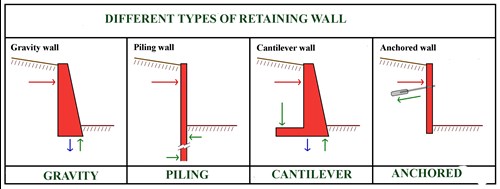The purpose of a retaining wall is to separate different levels of soil in a terrain intended by nature to be sloped. As a result of this natural tendency, there is a constant natural force behind the wall, putting pressure on the wall and trying to return the soil to its natural sloping state.
The lateral forces exerted on a retaining wall by earth and water can be immense. It is therefore vital that the structure is designed to withstand such pressure which may cause it to overturn or slide. Also, groundwater collecting behind the wall must be dissipated by a drainage system, thereby reducing the hydro-static pressure and improving the stability of the material behind the wall. (Dry-stone walls are normally self-draining.)

Insuring a Retaining Wall
Insurance companies prefer to steer away from retaining walls as they are generally not properly designed or constructed. When a retaining wall fails, the consequences can be devastating and quite costly. Therefore, cover for retaining walls are mentioned separately in the policy and most likely, attract an additional premium.
Insurers require proof that a retaining wall meets the design specifications required for the particular environment in which it was erected. While such design and construction certification should be readily available for newer retaining walls, proof that older retaining walls are ‘engineer-designed’ is rarely available. It is seldom possible to determine the design type and structural integrity of a retaining wall just from examining it externally. Moreover, the foundations will need to be exposed in various locations and the wall inspected by a structural engineer – in some cases taking core samples. Once the engineer is satisfied that the retaining wall is structurally sound and fit for purpose, a stability report is issued.
The cost of this professional service together with the excavation works appears excessive for many property owners and they often decide just to live with the risk.
While regular – and costly – maintenance can prolong the life of a retaining wall, it is inevitable that all retaining walls will reach the end of their serviceable life sooner or later.
As insurance companies are aware of this, most – if not all – policies specifically exclude damage by storm, wind, water, hail or snow. The collapse of a retaining wall is seldom the result of a sudden event such as high winds or flooding but rather due to lack of maintenance or inadequate design or construction.
Nothing lasts forever.
Read part 2 of this blog: Retaining walls: The risk explained 2.
Cookies are necessary to operate this website. You may withdraw your consent to cookies at any time by selecting/setting your preferences on your user profile.
In order to proceed with using Mirfin's website, it is mandatory to accept cookies. You may withdraw your consent to cookies at any time by setting your preferences on your user profile.

